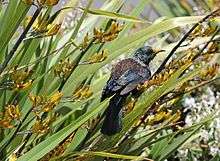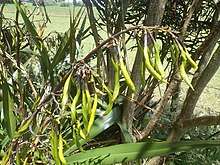Phormium colensoi
Phormium colensoi (syn. Phormium cookianum; mountain flax, lesser New Zealand flax,[5] or wharariki in Māori) is a perennial plant that is native to New Zealand.[6] It is less common than the other Phormium species, P. tenax. The greenish, yellow or orange flowers are followed by twisted seed pods.[6]
| Phormium colensoi | |
|---|---|
 | |
| Mountain flax being visited by a tui | |
| Scientific classification | |
| Kingdom: | Plantae |
| Clade: | Tracheophytes |
| Clade: | Angiosperms |
| Clade: | Monocots |
| Order: | Asparagales |
| Family: | Asphodelaceae |
| Subfamily: | Hemerocallidoideae |
| Genus: | Phormium |
| Species: | P. colensoi |
| Binomial name | |
| Phormium colensoi | |
| Synonyms[2] | |
_1.jpg)

Description
The leaves are under 2 metres in length while those of P. tenax range from 1 to 3 metres in length.[7] The scape is much shorter than that of P. tenax, rising up to 2 metres in height while that of P. tenax is around 5 metres in height.[7] The colour of the inner tepals is green while the outer tepals are yellow to red.[7] In contrast the tepals of P. tenax are a dull red, with the tips of the inner tepals being less strongly recurved.[7] The capsules of P. colensoi, unlike those of P. tenax are twisted and pendulous, and may be twice as long (up to 20 cm in length).[7]
Phormium colensoi has two distinct geographic forms, one occurring in lowland parts of the North Island, and the other in the southern and mountainous areas of the South Island as well as ranges in the North Island. The lowland form has green or yellow tepals and the mountain form has red tepals.[7] In the Cook Strait area, both forms and intermediates can be found.[7]
Taxonomy
The species was originally mentioned without description by William Colenso, the name being given as Phormium forsterianum.[8][9] It was later known as P. colensoi, a name that was listed without description in 1846 by Joseph Dalton Hooker.[10] The name became better known from J. D. Hooker's 1864 publication in Handbook of the New Zealand Flora.[8] However, previously, in 1848, Auguste François Le Jolis had described the species under the name P. cookianum,[8][11] and for many years this name was thought to have priority over Hooker's name P. colensoi. The latter is now regarded as the accepted name, based on a brief description of the species in a quotation from J.D. Hooker in an article by Auguste Le Jolis in the Revue Horticole of 1 January 1848.[12][13] Another specimen, believed to be identical to a plant found by Ronald Gunn at the Whanganui River[14] in 1864, was described from a plant growing in a garden in Torquay, England in 1888 and given the name P. hookeri (later reduced to a subspecies under the name P. cookianum subsp. hookeri).[8] This name is also now regarded as a synonym of P. colensoi.[15]
Cultivars
Numerous cultivars of this species have been selected for cultivation (those marked agm have gained the Royal Horticultural Society's Award of Garden Merit):-[16]
- 'Black Adder' [17]
- 'Cream Delight'agm[18]
- 'Dark Delight' has deep-red leaves up to 1.2 metres in length[19]
- 'Duet', a dwarf cultivar up to 30 cm in height with cream and green variegated foliage[19]
- 'Flamingo'[17]
- 'Golden Wonder'[17]
- 'Maori Maiden' (also known as 'Rainbow Maiden'), an erect growing cultivar with leaves to 1 metre in length with bronze stripes[19]
- 'Sundowner', a cultivar with very long leaves which are up to 1.8 metres long. These have a purple centre and cream edges.[19]
- 'Tricolor',agm[20] an upright cultivar that has leaves with red, yellow and green stripes. The flowers are pale yellowish-green.[19]
There is also a dwarf cultivar, and hybrid cultivars have been selected from crosses with Phormium tenax.[17] P. colensoi cultivars are regarded as less hardy than other Phormium cultivars.[21]
Uses
Numerous traditional cultivars have been used by the Māori people for various purposes:
- Wharariki - a variety from Urewera has a superior fibre quality that may be woven into a soft kete (traditional Māori basket). It has a slight yellow colouration when dried. Another variety from Tairāwhiti is suitable for soft baskets, rorou and toys.[22]
- Whakaari - a variety with leaves suitable for weaving ketes, but less suitable than other cultivars for piupiu (Māori skirts). The leaves have strong blades and dry naturally to a deep green colour, or to a pale greenish-fawn after being boiled for a minute.[22]
References
- "Taxon: Phormium colensoi Hookf". The Plant List. Royal Botanic Gardens, Kew and Missouri Botanical Garden. Retrieved 2012-08-26.
- "Phormium colensoi". World Checklist of Selected Plant Families. Royal Botanic Gardens, Kew. Retrieved 2014-08-21.
- "Phormium cookianum subsp. hookeri". International Plant Names Index. Retrieved 2014-08-30.
- "Phormium hookeri". International Plant Names Index. Retrieved 2014-08-30.
- "BSBI List 2007". Botanical Society of Britain and Ireland. Archived from the original (xls) on 2015-01-25. Retrieved 2014-10-17.
- "Harakeke/flax" (PDF). Department of Conversation. Retrieved 2009-01-25.
- Wardle, P. (1979). "Variation in Phormium cookianum (Agavaceae)". New Zealand Journal of Botany. 17: 189–196. doi:10.1080/0028825x.1979.10426888. Retrieved 2011-05-08.
- "P. cookianum". Flora of New Zealand Series. Landcare Research. Retrieved 2009-01-28.
- "Journal of a naturalist in some little known parts of New Zealand, by William Colenso, Esq., in a letter to Sir W. J. Hooker (page 8)". London Journal of Botany. 3: 1–62. 1844.
- Étienne Fiacre Louis Raoul (ed.). 'Choix de plantes de la Nouvelle-Zélande. p. 41.
- "Phormium cookianum". World Checklist of Selected Plant Families. Royal Botanic Gardens, Kew. Retrieved 2012-08-29.
- "Phormium colensoi". World Checklist of Selected Plant Families. Royal Botanic Gardens, Kew. Retrieved 2012-08-28.
- le Jolis, Auguste (1848). "Note sur la floraison du Lin de la Nouvelle-Zélande à Cherbourg". Revue Horticole, Series III. 2: 5–8. Retrieved 2012-08-28. p. 6.
- Earp, Clem (2014). "A correspondence long interrupted: Ronald Gunn re-establishes contact with Joseph Hooker in 1870". Victorian Naturalist. 131 (6): 204–208.
- "Phormium hookeri". World Checklist of Selected Plant Families. Royal Botanic Gardens, Kew. Retrieved 2012-08-28.
- "AGM Plants - Ornamental" (PDF). Royal Horticultural Society. July 2017. p. 78. Retrieved 25 April 2018.
- "RHS Plant Finder". Royal Horticultural Society. Retrieved 2009-01-28.
- "RHS Plant Selector - Phormium cookianum subsp. hookeri 'Cream Delight'". Retrieved 22 July 2013.
- Turner, R.G. (1999). Botanica. Barnes & Noble Pty Ltd. ISBN 0-7607-1642-0.
- "RHS Plant Selector - Phormium cookianum subsp. hookeri 'Tricolor'". Retrieved 22 July 2013.
- "Phormium cultivation". Fernwood Nursery. Retrieved 2009-01-28.
- "Harakeke weaving varieties – complete list of cultivars in the Rene Orchison collection". Landcare Research. Retrieved 2009-01-28.
| Wikimedia Commons has media related to Phormium colensoi. |